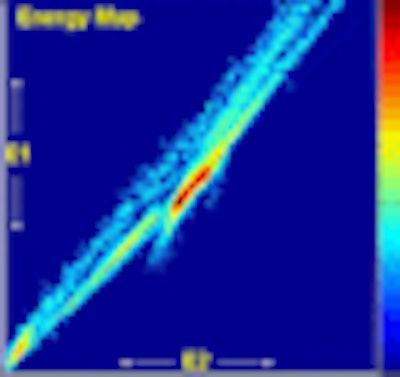
BOSTON - Researchers in Jerusalem are pushing the envelope with a novel dual-energy CT scanner and software combination that detects fecal residue tagged with barium and iodine, removing them from virtual colonoscopy images and making them easier to read. The scanner, the software, and the study are all works-in-progress, but the system appears to work, at least in the small number of patients that have been scanned initially in the ongoing study.
Patient surveys have shown convincingly that the cathartic bowel prep is the most unpleasant aspect of both conventional and virtual colonoscopy (VC or CT colonography). Researchers believe the prep is at least part of the reason why fewer than half of adults over 50 years of age get screened for colorectal cancer.
In an effort to increase screening compliance, studies have been performed with a variety of noncathartic bowel preparations combined with fecal tagging. The preparations are easier on patients, but tough on VC providers who are tasked with finding polyps amid the tagged fecal residues.
"The aim of our study was to compare reduced cathartic dual-energy [CT colonography (CTC)] with optical colonoscopy for evaluation of colorectal polyps," said Liran Goshen from Philips Healthcare of Andover, MA. "We hypothesized that dual-energy CTC can reliably detect polyps 10 mm and larger and perform better electronic cleansing." Goshen presented preliminary results on Tuesday at the International Symposium on Virtual Colonoscopy.
The study, led by Dr. Jacob Sosna from the Hadassah Medical Center in Jerusalem, was performed using an experimental dual-energy scanner (Brilliance Simultaneous Dual Energy CT prototype, Philips Healthcare) based on a single x-ray tube, but with two different scintillators in the detector made of different materials that are sandwiched together, Goshen said. "The inner layer absorbs mainly the lower energies, and the outer layer absorbs mainly the higher energies," he explained.
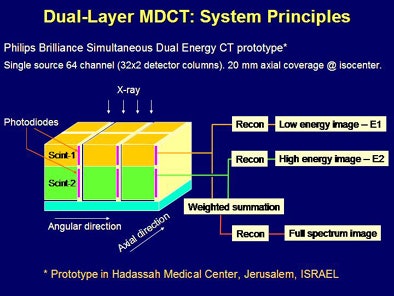 |
| The Philips Brilliance Simultaneous Dual Energy CT prototype scanner utilizes a single energy source combined with two scintillators sandwiched together. The scanner outputs separate data from each scintillator, as well as a dual-energy dataset combining all of the image data. All images courtesy of Liran Goshen and Philips Healthcare. |
The scintillator configuration results in the reconstruction of separate images for each layer, as well as a third reconstruction based on the combined energies, he said. With 64 detector rows, a 50-mm field-of-view and 20-mm coverage, the prototype installed in the Hadassah Medical Center has scanned more than 1,000 patients to date for various indications, he said.
As with dual-source CT scanning, the differentiation of scanned materials on the dual-energy scanner is accomplished by analyzing the distinct attenuation properties of materials in two different photon energy environments. However, the prototype machine differentiates the energies based on different scintillator properties rather than the production of two different tube energies.
A useful way to illustrate the spectral information for various materials is to look at the energy map, a 2D map that plots the low energies on the y-axis and the high energies on the x-axis, Goshen said. Each material on the map -- for example, soft tissue, fat, and barium -- has different spectral properties that can be mapped individually, permitting better material analysis.
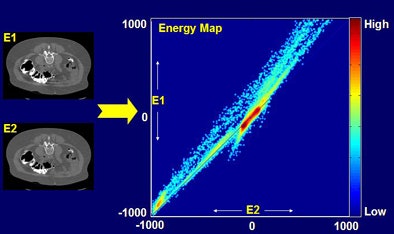 |
| Spectral information from dual-energy scanning is depicted on the energy map, a two-dimensional map that plots low energies from one scintillator on the y-axis and high energies from the other scintillator on the x-axis. Each material -- for example, soft tissue, fat, and barium (below) -- has distinct spectral properties that can be mapped individually, permitting improved analysis of scanned materials. |
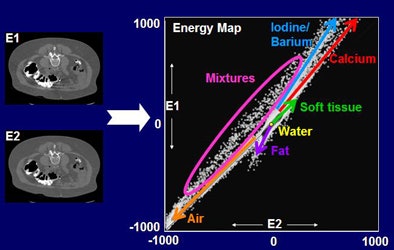 |
The tagging protocol in the study included Tagitol V barium preparation and iopamidol oral iodine (both from Bracco Diagnostics, Princeton, NJ) in four split doses, Goshen said. Before electronic cleansing was performed, each dataset was scored for quality based on the amount of residual fecal material, including both fluid and stool. The residual fluid in the colon was rated as homogeneously or inhomogeneously tagged.
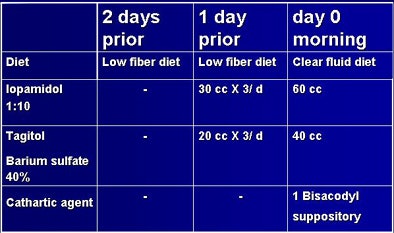 |
| All seven patients underwent a reduced cathartic bowel prep over three days. |
The researchers applied two electronic cleansing techniques developed by Philips to each dataset. The first technique (ES1) used the multienergy information in the images to differentiate residual materials (tagged and untagged stool, fluid) and tissues including polyps and folds. The second technique (ES2) was a traditional threshold-based tool. In each of seven cases, segmentally unblinded optical colonoscopy with full cathartic bowel prep was performed on all subjects with an elevated risk of colorectal polyps within three weeks of CTC; the colonoscopy results served as the reference standard for the study.
None of the seven patients had a polyp larger than 1 cm at optical colonoscopy, Goshen said. "So far the new algorithm [ES1] has shown better results, especially in cases of nonhomogeneously tagged residual material," he noted.
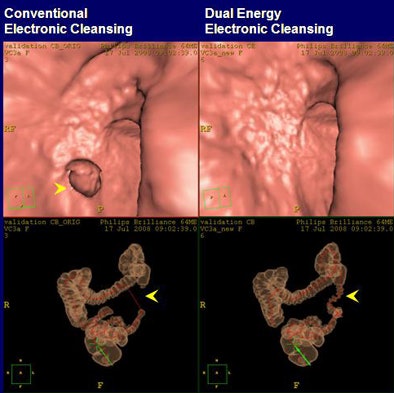 |
| Above, polypoid residual fecal material (15 mm) was left in place by the conventional electronic cleansing algorithm (upper left) but removed by the dual-energy algorithm (upper right). Dual-energy mapping with electronic cleansing also enabled better segmentation and identification of the descending colon. In the axial view (below) of the same case, images at left depict conventional CTC with simple thresholds applied. Images at right show the iodine and barium dual-concentration map with the electronic cleansing thresholds applied. |
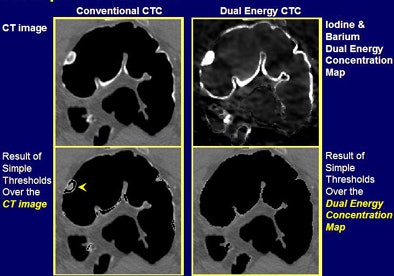 |
In CTC, dual-energy imaging offers two main advantages: it eliminates internal inhomogeneities in the lumen and it reduces partial-volume effect, Goshen said. All of the 3D images have been of diagnostic quality following application of the dual-energy electronic cleansing technique.
To date there have been no cases in which spectral CT combined with the electronic cleansing method removed colonic mucosa rather than residual materials; however, the method remains too preparation-dependent and needs additional modification to accommodate a wider variety of preps, Philips researchers told AuntMinnie.com in an interview after the talk.
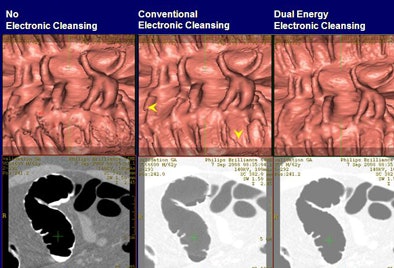 |
| In this example, filet views (top row) and axial views (bottom row) show residual fecal material left by conventional electronic cleansing (arrows, middle column), while electronic dual-energy cleansing removed them successfully (right column). |
"Reduced cathartic prep CTC with spectral CT electronic cleansing is feasible, with improved visualization of the colon," Goshen concluded. "We plan to utilize the method further in order to illustrate completely noncathartic preparation. We look forward to presenting more data as the study progresses."
By Eric Barnes
AuntMinnie.com staff writer
October 29, 2008
Related Reading
Dual-energy CT helps distinguish malignant lung nodules, October 8, 2008
DECT aces noninvasive gout diagnosis, September 15, 2008
Color-coded tagging software speeds VC interpretation, September 5, 2008
Image tools cut false positives in unprepped VC, August 4, 2008
Tagging trials: Balancing image quality with patient acceptance in VC, April 16, 2008
Copyright © 2008 AuntMinnie.com



















